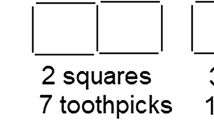Abstract
In this study we utilize the notion of learner-generated examples, suggesting that examples generated by students mirror their understanding of particular mathematical concepts. In particular, we explore examples generated by a group of prospective secondary school teachers for a definition of a square. Our framework for analysis includes the categories of accessibility and correctness, richness, and generality. Results shed light on participants’ understanding of what a mathematical definition should entail and, moreover, contrast their pedagogical preferences with mathematical considerations.



Similar content being viewed by others
References
Borasi, R. (1992). Learning mathematics through inquiry. Portsmouth, NH: Heinemann Educational Books.
Cooney, T. J., & Wilson, M. R. (1993). Teachers’ thinking about functions: Historical and research perspectives. In T. A. Romberg, E. Fennema, & T. P. Carpenter (Eds.), Integrating research on the graphical representation of functions (pp. 131–158). Hillsdale, NJ: Lawrence Erlbaum.
Dahlberg, R. P., & Housman, D. L. (1997). Facilitating learning events through example generation. Educational Studies in Mathematics, 33(3), 283–299.
De Villiers, M. (1998). To teach definitions in geometry or to teach to define? In A. Olivier, & K. Newstead (Eds.), Proceedings of the 22nd Conference of the International Group for the Psychology of Mathematics Education (vol. 2, pp. 248–255). Stellenbosch: RSA.
Edwards, B. (1997). An undergraduate student’s understanding and use of mathematical definitions in real analysis. In J. Dossey, J. Swafford, M. Parmantie, & A. Dossey (Eds.), Proceedings of the 19th Annual Meeting of the North American Chapter of the International Group for the Psychology of Mathematics Education (vol. 1, pp. 17–22). Colulmbus, OH: The ERIC Clearing house for Science, Mathematics, and Environment Education.
Edwards, B. S., & Ward, M. B. (2004). Surprises from mathematics education research: Student (mis)use of mathematical definitions. The American Mathematical Monthly, 111(5), 411–424.
Fischbein, E. (1987). Intuition in science and mathematics. An educational approach. Dordrecht: Kluwer.
Freudenthal, H. (1973). Mathematics as an educational task. Dordrecht: Reidel.
Khinchin, A. Y. (1968). The teaching of mathematics. London: The English Universities Press.
Leikin, R., & Levav-Waynberg, A. (2007). Exploring mathematics teacher knowledge to explain the gap between theory-based recommendations and school practice in the use of connecting tasks. Educational Studies in Mathematics, 66(3), 349–371.
Leikin, R., & Winicky-Landman, G. (2000). On equivalent and nonequivalent definitions II. For the Learning of Mathematics, 20(2), 24–29.
Leikin, R., & Winicky-Landman, G. (2001). Defining as a vehicle for professional development of secondary school mathematics teachers. Mathematics Teacher Education and Development, 3, 62–73.
Linchevsky, L., Vinner, S., & Karsenty, R. (1992). To be or not to be minimal? Student teachers’ views about definitions in geometry. In W. Geeslin, & K. Graham (Eds.), Proceedings of the 16th Conference of the International Group for the Mathematics Education (vol. 2, pp. 48–55). Durham, New Hampshire.
Mariotti, M. A., & Fischbein, E. (1997). Defining in classroom activities. Educational Studies in Mathematics, 34(3), 219–248.
Mason, J. (1998). Researching from the inside in mathematics education. In A. Sierpinska, & J. Kilpatrick (Eds.), Mathematics Education as a research domain: A search for identity (pp. 357–377). Dordrecht: Kluwer.
Musser, G. L., Burger, W. F., & Peterson, B. E. (2006). Mathematics for elementary teachers: A contemporary approach. New York: Wiley.
Pimm, D. (1993). Just a matter of definition. Educational Studies in Mathematics, 25, 261–277.
Poincare, H. (1909/1952). Science and method. New York, NY: Dover.
Solow, D. (1984). Reading, writing and doing mathematical proofs. Book I. Palo Alto, CA: Dale Seymour.
Tall, D., & Vinner, S. (1981). Concept image and concept definition in mathematics—With particular reference to limits and continuity. Educational Studies in Mathematics, 12, 151–169.
Tirosh, D., & Even, R. (1997). To define or not to define: The case of (−8)1/3. Educational Studies in Mathematics, 33(3), 321–330.
van Dormolen, J., & Zaslavsky, O. (2003). The many facets of a definition: The case of periodicity. Journal of Mathematical Behavior, 22(1), 91–106.
Vasco, C. E. (2006). Cronotopía: Un “Programa de Bogotá” para lo que se suele llamar “Geometría”. In C. Ruiz, et al. (Eds.), Memorias: XVI Encuentro de Geometría y sus aplicaciones-IV Encuentro de aritmética (vol. 1, pp. 1–28). Bogotá: Universidad Pedagógica Nacional.
Vinner, S. (1991). The role of definitions in the teaching and learning of mathematics. In D. O. Tall (Ed.), Advanced Mathematical Thinking (pp. 65–81). Dordrecht: Kluwer.
Vinner, S., Linchevski, L., & Karsenty, R. (1993). How much information should include a geometrical definition? Zentralblatt für Didaktik der Mathematik, 25, 164–170.
Vygotsky, L. S. (1982). Mishlenie i rech (Thought and language). In L. S. Vygotsky (Ed.), Sobranie Sochinenii, t.2. Moscow: Pedagogika (in Russian).
Watson, A., & Mason, J. (2005). Mathematics as a constructive activity: Learners generating examples. Mahwah, NJ: Lawrence Erlbaum.
Weinstein, E. (2007a). Wolfram MathWorld: Polygon. Retrieved March 15, 2008 from http://www.mathworld.wolfram.com/Polygon.html.
Weinstein, E. (2007b). Wolfram MathWorld: Square. Retrieved March 15, 2008 from http://www.mathworld.wolfram.com/Square.html.
Winicky-Landman, G., & Leikin, R. (2000). On equivalent and nonequivalent definitions I. For the Learning of Mathematics, 20(1), 17–21.
Zaslavsky, O., & Shir, K. (2005). Students’ conceptions of a mathematical definition. Journal for Research in Mathematics Education, 36(4), 317–346.
Zazkis, R., & Leikin, R. (2007). Generating examples: From pedagogical tool to a research tool. For the Learning of Mathematics, 27, 11–17.
Author information
Authors and Affiliations
Corresponding author
Rights and permissions
About this article
Cite this article
Zazkis, R., Leikin, R. Exemplifying definitions: a case of a square. Educ Stud Math 69, 131–148 (2008). https://doi.org/10.1007/s10649-008-9131-7
Received:
Accepted:
Published:
Issue Date:
DOI: https://doi.org/10.1007/s10649-008-9131-7




